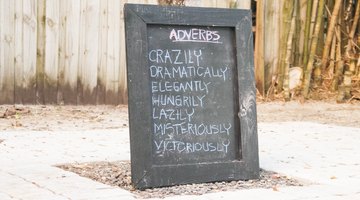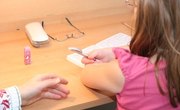Learning and teaching grammar can become tedious fairly quickly. The endless worksheets of fill-in-the-blank sentences can put both students and teachers to sleep. When you teach adverbs, spice up your lessons to help your students remember what an adverb is and how to use it. Adverbs modify verbs, other adverbs and adjectives, which makes them easy to teach in fun ways. You can make them interesting with some fun adverb activities.
Play Simon Says
One fun way to teach adverbs is to play “Simon Says,” according to BrainPop.com. However, instead of “Simon” issuing verb commands to walk forward four steps, for example, “Simon” adds an adverb to the verb. The command could then be, “Walk forward crazily four steps.” Put up a list of adverbs on the board to give students some help when they first begin playing. As they become better at thinking of adverbs, remove the list from the board. Have a student volunteer to write the list of adverbs on the board. When the game is over, students can copy the sentences down and circle or highlight the adverb in each one.
Add to Sentences
Put a simple sentence on the board such as, “She eats lunch.” Students then add adjectives and adverbs to the sentence. You might have them come to the board and add to the sentence with different-colored chalk or markers, or you could give them card stock with tape on the back to write their words on before they add them to the simple sentence. You could also divide students into teams and have a competition to see who can create the best sentence; let a few students in the class serve as judges. Students can also complete the activity individually and share their sentences with the class. Identify the adverbs as a class when students finish the activity.
Scavenger Hunt
A fun adverb activity for middle school begins with writing sentences with adjectives and adverbs on card stock of different colors, or using different-colored ink for each sentence. There should be one word card for each student in the class. Hide the cards around the room in safe locations. Have students move through the room looking for the different cards. Each student should have only one card. When students find all of the cards, have them find other students with the same color card. Then students should arrange their cards into a sentence and write it on the board. After they write their sentences on the board, they circle the adverbs. The first team to finish wins the game. You can also do this activity on worksheets by having students identify the adverbs on it. Tell the students how many adverbs are on the worksheet, and make sure there are adjectives on it, too, to make the activity more challenging. The winner is the first student who identifies all of the adverbs correctly.
Creating a List
Provide your students with a verb, adverb, or an adjective. Tell them to write down an adverb that describes the word you give them. Then write down each student’s word on the board. The class can vote on the most creative one. Then give students an adjective and a noun. Students should then come up with as many adverbs as they can to describe the subject you gave them. For example, if you write “sad clown” on the board, the winner of this game would be the student who could come up with the longest adverb chain to describe the sad clown. Someone might write “never a very sad clown,” for example.
Related Articles
References
Writer Bio
Leyla Norman has been a writer since 2008 and is a certified English as a second language teacher. She also has a master's degree in development studies and a Bachelor of Arts in anthropology.











